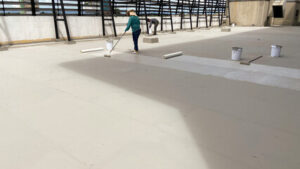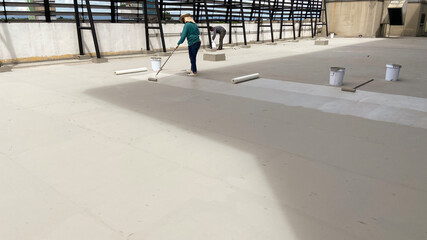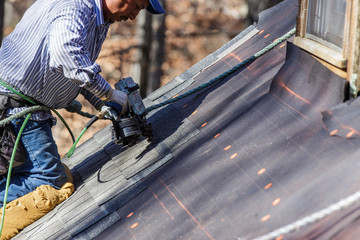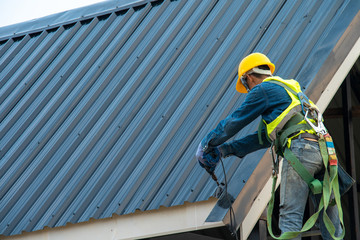Roof coatings add a protective layer that fends off weathering, UV damage, and physical damage to the existing membrane. This helps extend the life of your commercial roofing system and reduces the need for costly repairs or replacement.

It’s also easy to maintain. A roof coating can be sprayed or roll-applied without the need for primer, saving time, materials, and energy. Contact We Coat – Commercial Roof Coating In North Carolina for professional help.
Roof coatings are more expensive than traditional roofing materials, but they offer a significant return on investment in the long term. Case studies and ROI metrics can help businesses to understand the financial benefits of commercial roof coating systems, including energy efficiency gains that reduce cooling costs, and extended roof lifespans that lower the need for costly replacements.
To ensure that you get the best value for your money, choose a quality product from an experienced roof coating specialist. Cheaper products from your local home improvement store are not recommended, as they often have low performance and will eventually cause problems such as leaks, deterioration, incompatibility with other roofing materials, or even worse — a full-on roof failure!
When choosing a contractor, consider how personable they are and whether or not you feel comfortable working with them. They should be willing to listen to your needs and answer any questions you may have. They should also be able to explain any issues or concerns that you may have about your roof coating system, as well as provide you with a clear estimate for the project.
Commercial roof coatings are spray or roll-applied directly to the existing roofing surface, forming a new monolithic layer that protects the building from leaks. The coating system is made up of multiple resins that work together to maintain the membrane’s elasticity, bridge small cracks in the roof, and provide additional waterproofing. The coating material is also formulated with UV-absorbing ingredients that shield the roof from sun damage and extend its lifespan.
The entire roof coating installation process is quick, quiet, and easy. It will not disrupt operations or shut down production, and can be completed in just a few hours or days (depending on the size of your roof).
For these reasons, Commercial Roof Coating is an ideal solution for any property owner that wants to extend the life of their current commercial roof, or want to keep their building cool during Atlanta’s hot summers. The next post in this series will discuss the many other ways commercial roof coating can save you time and money.
Long-Lasting
The roof coating acts as an extra layer that shields the underlying roofing membrane from harsh weather conditions and UV radiation. This enhanced protection enables the roof to extend its lifespan, thus preventing premature aging and deterioration. This helps reduce the need for repairs or roof replacements, which in turn saves time and money for commercial property owners.
Another benefit of coating a commercial roof is that it contributes to sustainability efforts. By extending the life of existing roofing systems, commercial roof coating prevents the disposal of excess materials and preserves natural resources that would otherwise be used in the production of new roofing material. This also minimizes the need for full roof replacement, which in turn cuts down on landfill waste and energy costs associated with the manufacturing of new roofing products.
Additionally, the roof restoration process typically causes less disruption to a facility’s operations than a full re-roof. This means that a building’s tenants can continue operating normally while the roof is being restored with a protective coating.
One final advantage of commercial roof coating is that it is easy to maintain over time. Regular inspections, periodic surface cleaning to remove debris and dirt, and prompt addressing of any roofing issues help to uphold the longevity and effectiveness of the coating.
When choosing a contractor to install a roof coating, it’s important to do your homework. Look for a roofing company with testimonials from satisfied clients and an excellent reputation for quality work. You should also be sure to get multiple estimates before making a decision.
A reputable roofing company will provide you with an honest assessment of the condition of your commercial roof and recommend the most appropriate solution. They’ll also be able to explain the benefits and advantages of the specific roof coating you have in mind. A high-quality roof coating is a smart investment that can protect your commercial facility for decades to come. Contact us at United Contracting & Roofing today to learn more about how we can restore your roof with a protective coat. We offer a wide range of roofing services, including roof coating, to commercial properties in Atlanta and beyond.
Easy to Apply
Commercial roof coatings are either sprayed or rolled onto existing roofing materials, and they’re very easy to install. The application process doesn’t make much noise, doesn’t use any VOC’s and takes a day or two at most to complete (depending on the size of your roof). This is a great benefit for contractors who need to get jobs done quickly, and for building owners who want to stop leaks.
A qualified contractor should be able to inspect your roof and determine the type of roof coating you need. It’s important to choose a professional who has extensive experience working with your type of roof, is licensed and insured, and provides a warranty on the product they install. Also, it’s best to work with a contractor who has an impressive portfolio of previous projects. Look for photos of completed jobs that are similar to yours, as well as customer testimonials.
When properly applied, commercial roof coatings protect the existing roof from the elements and hold it together until a full replacement is needed. Often, roofing repairs are a result of roof damage from harsh weather conditions or excessive sun exposure. The right roof coating will limit this damage and save a building owner money in the long run, by deferring the need for an expensive and time-consuming roof replacement.
A quality commercial roof coating can be recoated when it begins to wear down, extending its life 10, 15, or even 20 years longer than an original roof installation. This is a major advantage over traditional roof systems that must be torn off and replaced entirely when they reach the end of their usefulness. In addition, roof coatings are ENERGY STAR-rated and can help lower energy costs for a building. By reflecting a large percentage of the sun’s radiation, they keep buildings cooler and reduce the demand for air conditioning, which translates into substantial cost savings for building owners. This is another reason why commercial roof coatings are the most cost-effective roofing solution for many business owners.
Seamless Appearance
Commercial roof coatings are able to bridge cracks and holes in the roofing material, providing a seamless appearance. This eliminates areas where water can work its way in and cause damage to the property below. The resulting surface is also able to reflect sunlight and keep the interior cool, which cuts down on energy costs. This type of roof coating is a great choice for building owners who want to reduce their cooling bills and extend the life of the existing roof.
Another important benefit of commercial roof coating is that it can be applied to almost any existing roofing system, including metal, single-ply membranes, and even sprayed-in-place polyurethane foam. This makes it a great option for business owners who are worried about the cost of a complete roofing replacement. In addition, roof coating can be applied quickly and with minimal disruption to the operation of the building.
A commercial roof coating can also help you save on your energy bill by reducing the amount of heat it absorbs. This is because the coating is able to reflect UV rays, keeping the roof and interior of the building cooler. This can save you money on your energy bills and reduce your carbon footprint.
The roof coating is a liquid that is applied to the existing roof and allowed to dry naturally over 8 to 24 hours. This will create a fully-adhered monolithic surface, which can protect the existing roof from harmful UV radiation, moisture, and extreme weather conditions. Some roof coatings are able to even prevent leaks by filling in cracks and gaps that may have developed in the previous roofing system.
Many of these coatings are low in VOCs and make no noise during application. They are also formulated to be safe for the environment, lowering greenhouse gas emissions and helping businesses to meet sustainability requirements.
A roof coating can help you save on your energy costs, extend the life of your existing roof, and make your building more comfortable and productive. If you are interested in learning more about this product or are ready to have it installed, contact a reliable roof contractor. They can offer a free consultation and estimate for the services you need.










 In addition to increasing the number of sales, an eCommerce site can use customer information for cross-selling purposes and to send promotional emails. Moreover, it provides a means to contact the business owner, as a customer, whenever they want to. Besides, the site owner can train a customer service agent to respond to questions or resolve any problems. Further, the online store owner can monitor customer satisfaction and identify any problems with their products. A customer review on an online store can be shared with potential customers.
In addition to increasing the number of sales, an eCommerce site can use customer information for cross-selling purposes and to send promotional emails. Moreover, it provides a means to contact the business owner, as a customer, whenever they want to. Besides, the site owner can train a customer service agent to respond to questions or resolve any problems. Further, the online store owner can monitor customer satisfaction and identify any problems with their products. A customer review on an online store can be shared with potential customers.